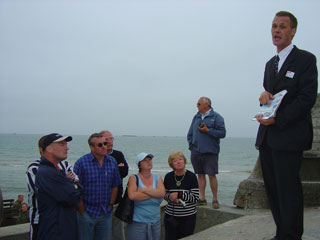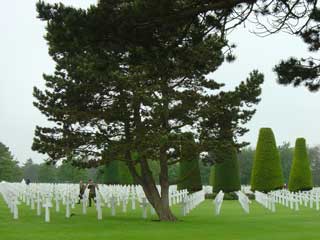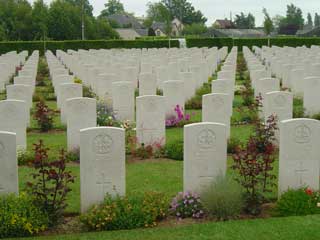A lay day in Caen
The Battlefield
Tour
Friday 4th June
 With
our visit to Caen coinciding with the 60th anniversary of D-day, it seemed an
ideal opportunity to learn a little more about this historic occasion by taking
advantage of a tour of the Normandy battle sites and memorials. Caen's Memorial,
a museum for peace, is a must see visit in this area and as well as time here
a group of 18 from the MBM fleet made up a coach party for a more extensive tour.
With
our visit to Caen coinciding with the 60th anniversary of D-day, it seemed an
ideal opportunity to learn a little more about this historic occasion by taking
advantage of a tour of the Normandy battle sites and memorials. Caen's Memorial,
a museum for peace, is a must see visit in this area and as well as time here
a group of 18 from the MBM fleet made up a coach party for a more extensive tour.
 Our
tour began at Arromanches, the artificial harbour on which construction began
on D-day +1. Despite the worst channel storm in 40 years, the harbour was up and
running within two months and in use until November of that year. The anniversary
celebrations and the impending visit of President Bush meant tightened security
all along the coast, and the town of Arromanches itself was closed to visitors.
Our
tour began at Arromanches, the artificial harbour on which construction began
on D-day +1. Despite the worst channel storm in 40 years, the harbour was up and
running within two months and in use until November of that year. The anniversary
celebrations and the impending visit of President Bush meant tightened security
all along the coast, and the town of Arromanches itself was closed to visitors.
 From
here we moved west to Longues-sur-mer, where a strategic German battery stands
untouched since it was overpowered by Allied Forces on the evening of 6th June
1944. Our informative guide explained how the laying of the telephone wires six
feet underground meant that once cut, they were impossible to repair, meaning
the German gunners were effectively unable to communicate with their coastal command
and control post.
From
here we moved west to Longues-sur-mer, where a strategic German battery stands
untouched since it was overpowered by Allied Forces on the evening of 6th June
1944. Our informative guide explained how the laying of the telephone wires six
feet underground meant that once cut, they were impossible to repair, meaning
the German gunners were effectively unable to communicate with their coastal command
and control post.
 Stops at the American cemetery at Colleville-sur-mer, and the Commonwealth cemetery
at Bayeux completed the morning. The first is the final resting place of those
US troops whose families chose not to repatriate the bodies and is a starkly uniform
site. In contrast, the Commonwealth cemetery houses British, Canadian and Australians,
as well as French, Poles, Soviets and even Germans who were lost in the same area.
The graves are planted with a range of flowers giving year round colour, and the
headstones are designed to include the battalion emblem of the deceased as well
as a personal message from the family. This approach seemed to offer a more personal
touch and created a more humane atmosphere.
Stops at the American cemetery at Colleville-sur-mer, and the Commonwealth cemetery
at Bayeux completed the morning. The first is the final resting place of those
US troops whose families chose not to repatriate the bodies and is a starkly uniform
site. In contrast, the Commonwealth cemetery houses British, Canadian and Australians,
as well as French, Poles, Soviets and even Germans who were lost in the same area.
The graves are planted with a range of flowers giving year round colour, and the
headstones are designed to include the battalion emblem of the deceased as well
as a personal message from the family. This approach seemed to offer a more personal
touch and created a more humane atmosphere.